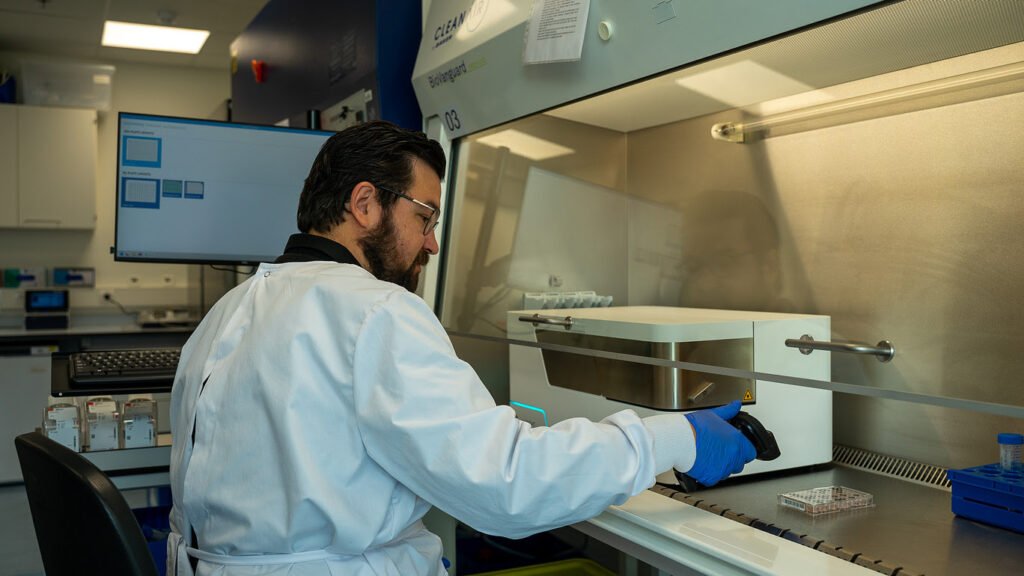hiPSC
Improving hiPSC Colony Outgrowth: How the UP.SIGHT™ Supports High-Quality Stem Cell Lines at LUMC
The Leiden hiPSC Centre supports biomedical research by offering a comprehensive range of human induced pluripotent cell (hiPSC) services to the scientific community. Committed to accelerate progress in human health, the Centre offers expert support in isolating and reprogramming of somatic cells to hiPSCs, genetic modification of hiPSCs with CRISPR/Cas9, project consultation and training. Its diverse collection of well-characterized hiPSC lines from healthy donors and genetically modified derivatives offers researchers a reliable platform to explore disease mechanisms, study human development and develop new therapies.
Industry
University Medical Center/Academia/ Non-profit service facility
CYTENA Instruments in Use
UP.SIGHT™
Using CYTENA Products Since
2024
Cell Types
iPSCs
Background
For researchers working with hiPSCs, ensuring the reliability of results is crucial especially in applications like disease modeling, drug testing, and therapy development. A key factor of this reliability comes from clonality, meaning the cell line must originate from a single, genetically uniform cell. Yet, achieving true monoclonality is no small feat.
Traditional methods like limiting dilution are time-consuming, labor-intensive, and often fail to guarantee clonality. This can lead to mixed populations and could compromise the reproducibility and accuracy of downstream experiments. Moreover, hiPSCs are highly sensitive to environmental stress, making them difficult to handle and prone to low survival rates during cloning. Overcoming these challenges is vital for producing reliable, high-quality cell lines that can support robust scientific discoveries and therapeutic advancements.
Challenge
At the Leiden hiPSC Centre, these challenges were all too familiar. The team frequently encountered a limited number of clones available for downstream analysis, which restricted their ability to identify successful edits. Even when clones were obtained, ensuring true monoclonality proved difficult. In some cases, raised concerns about the purity of the population.
Originally, manual cloning using 10 cm dishes or 96-well plates was performed. While generally this produced sufficient clones, clonality could not be guaranteed and the procedure was quite labour intensive. Alternative methods such as Fluorescence-Activated Cell sorting (FACS) proved logistically challenging and required cell culture in a quarantine lab post sort. Alternative single-cell dispensers were tested, but they proved difficult to operate and still failed to yield a sufficient number of viable clones.
The team knew a better solution was needed, but it was not until they received a grant for Large Scale Research Infrastructure from the Dutch Research Council (NWO) that they were able to act.
Solution

After a thorough evaluation of five different single-cell cloning systems, the Leiden hiPSC Centre selected the UP.SIGHT™ for its unique combination of precise single-cell dispensing and dual imaging technology. This enables both efficient isolation of individual cells and confident verification of clonality.
The UP.SIGHT™’s sterile, single-use cartridges eliminate cross-contamination risks, while features like fluorescent sorting and cell focusing technology reduces cell loss. The integrated C.STUDIO software provides real-time data tracking and streamlines decision-making. The ability to integrate the instrument into a fully automated cell culture setup was also a key factor in the decision.
Since its installation, the UP.SIGHT™ has become an indispensable component of the lab’s workflow. Following CRISPR/Cas9 treatment, cells are cloned using the device, resulting in hiPSC lines with true monoclonality and high survival rates.
- High-confidence verification of monoclonality through dual imaging
- Minimized cell loss thanks to fluorescent sorting and cell focusing
- Streamlined decision-making with real-time data tracking in C.STUDIO
- Improved survival rates of hiPSCs during cloning
- Seamless integration into automated cell culture workflows
Impact
After integrating the UP.SIGHT™ into the workflow, the team sees a significant increase in colony outgrowth, with rates rising to 40-60%, compared to just 30% with previous methods like flow cytometry.
With C.STUDIO’s real time tracking of colony confluency, the team is able to make faster and more precise decisions about which clones to expand, saving time and consumables.
The intuitive interface and minimal training requirements also mean that the UP.SIGHT™ can be used by researchers of other departments, who similarly reported improved survival rates and great confidence in clonality.
Reflecting on the impact, Christiaan Arendzen, Senior Technician, Leiden hiPSC Centre shared his experience:
“Cloning your hiPSC lines after gene-editing (and potentially after reprogramming) should be standard practice. We would recommend the UP.SIGHT ™. With its automation and precision, the system has the potential to become the benchmark for single-cell cloning.”





